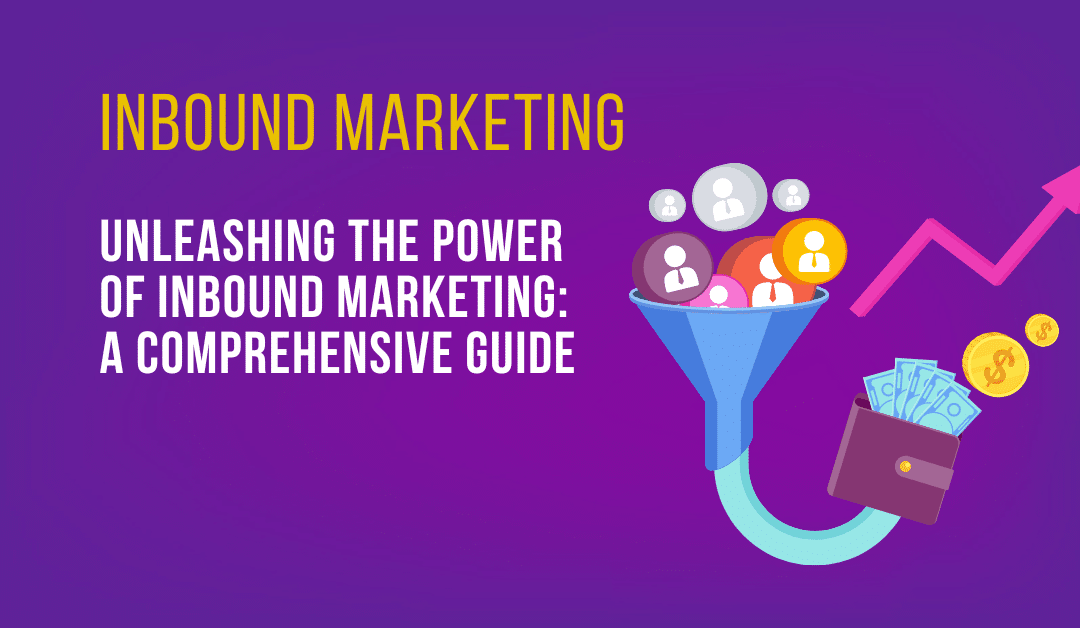Introduction to Inbound Marketing
Ever wondered why some businesses effortlessly attract customers while others struggle to make a single sale? The answer lies in the magic potion of inbound marketing. In today’s digital age, traditional marketing approaches are falling out of favor, and inbound marketing is taking center stage.
Inbound marketing is a strategic methodology that focuses on creating valuable content tailored to your target audience. It’s about providing solutions to their problems and establishing long-lasting relationships. Unlike outbound marketing, which can often feel intrusive, inbound marketing resonates with your audience because it offers them exactly what they are looking for, exactly when they need it.
The beauty of inbound marketing is that it’s not about forcefully pushing your brand in front of customers. Instead, it’s about attracting potential customers to you by offering high-quality, relevant content that they find genuinely engaging and useful. This audience-targeted approach can be the game-changer for your business.
Whether it’s through blog posts, webinars, or social media, every piece of content you create is a chance to attract new customers, engage with them, and ultimately convert them into loyal brand advocates.
In the following sections, we’ll explore the core elements of inbound marketing, its methodology, and how to harness its power to grow your business. Whether you’re a small business owner, a marketing professional, or an entrepreneur, this comprehensive guide will help you understand and unleash the power of inbound marketing.
It’s time to stop chasing customers and start attracting them. Let’s dive into the world of inbound marketing.

Understanding the Inbound Marketing Methodology
Inbound marketing is like a well-choreographed dance, with each step leading seamlessly to the next. It revolves around three crucial stages: Attract, Engage, and Delight. These stages form the core of the inbound marketing methodology and are the building blocks for creating meaningful, lasting relationships with your prospects and customers.
The Attraction Phase
The first stage of the inbound methodology is the Attraction phase. Here, the goal is not just to get traffic but to attract the right traffic to your website or blog.
This is achieved by creating and sharing valuable, relevant content tailored to your audience’s needs and interests. Whether it’s blog posts, webinars, or social media updates, every piece of content you create should provide value, addressing your audience’s questions, challenges, and pain points.
Moreover, you must optimize your content with an SEO strategy. This means targeting specific keywords and phrases related to your products or services, the challenges you solve for customers, and how you can help your target audience. This ensures that your content organically appears on search engine results pages (SERPs), attracting your ideal customers to your business.
The Engagement Phase
The next stage is the Engagement phase. In this phase, the focus is on building and nurturing relationships with your leads and customers. This involves communicating in a way that makes your audience want to engage with you and build long-term relationships.
Engaging strategies could include how you manage inbound sales calls, how your customer service representatives handle inquiries, or how you approach solution selling rather than product selling. The key is to inject value into every interaction, ensuring mutually beneficial agreements for both your customers and your business.
The Delight Phase
The final stage of the inbound methodology is the Delight phase. This phase is all about ensuring customers are happy, satisfied, and supported long after they make a purchase.
Delighting strategies can involve using timely chatbots and surveys to assist, support, and request feedback from customers. Social media listening, in which you respond to customer interactions with helpful and supportive information, is another powerful strategy. The ultimate goal is to make every customer interaction count, transforming satisfied customers into brand advocates and promoters.
By understanding and implementing these three stages of the inbound marketing methodology, you empower your business to attract, engage, and delight customers, driving sustainable business growth.

The Power of the Inbound Marketing Flywheel
Spinning your way to success might sound like a fairground ride, but in reality, it’s a strategy that many thriving businesses use. Welcome to the world of the inbound marketing flywheel.
The flywheel is a concept that represents how your business can gain momentum by prioritizing and delivering outstanding customer experiences. Think of it as a wheel that keeps turning due to the forces applied to it. These forces are the strategies you implement to attract, engage, and delight your customers. The more effective your strategies, the faster your flywheel spins, leading to stronger business growth.
But just like any wheel, your flywheel can also experience friction, which slows it down. This often happens during the handoffs between your teams. Therefore, proper alignment and communication within your teams are key to keeping your flywheel spinning smoothly.
Let’s delve further into how the different functions in your organization contribute to this flywheel.
Attract, Engage, Delight: Forces for Your Flywheel
The power of the flywheel comes from the three core stages of the inbound methodology: attract, engage, and delight.
In the attract stage, your marketing team plays a significant role in generating valuable content and running paid ads to draw in the right prospects. Your sales team can also contribute by engaging in social selling, while your customer service team can help by making referrals easier for current customers.
In the engage phase, you present insights and solutions that align with your prospects’ challenges and goals, making them more likely to purchase from you.
The delight stage focuses on providing help and support to ensure your customers find success with their purchases. This can turn them into promoters of your business, bringing in new prospects and keeping the flywheel spinning.
Removing Friction from Your Flywheel
Just as you apply forces to spin your flywheel, you need to minimize friction that can slow it down. This involves identifying any obstacles that hinder your customer’s journey and finding ways to eliminate them.
Ultimately, the power of the inbound marketing flywheel lies in its ability to self-perpetuate. Once you’ve attracted enough customers and effectively engaged and delighted them, they can keep your flywheel spinning by promoting your business and attracting new customers. Over time, this allows your business to grow without continually investing in customer acquisition.
By leveraging the inbound marketing flywheel, you can create a self-sustaining mechanism that drives business growth and customer satisfaction – a true win-win situation.
Inbound Marketing Content Types and Their Importance
A symphony isn’t created with a single instrument; it’s the harmonious blend of different sounds that create a melodious masterpiece. Similar is the case with inbound marketing. It isn’t about relying on just one type of content but utilizing a variety of content types to attract, engage, and delight your audience.
Inbound marketing content types can be as diverse as your audience’s interests and needs. From blog posts, e-books, and white papers to infographics, videos, webinars, and more, the content you produce should align with your audience’s needs at various stages of their buying journey.
Blog Posts: Blogging is a powerful way to attract visitors to your site, provide valuable information, and establish your brand as an authority in your field. Blogs should be informative, engaging, and SEO-optimized to drive organic traffic.
E-books & White Papers: These are in-depth pieces of content that provide comprehensive insights on a particular topic. They are excellent for generating leads as they are often exchanged for contact information.
Infographics: Infographics simplify complex information into easily digestible, visually appealing content. They are great for social sharing and can significantly increase engagement.
Videos: Video content is highly engaging and can effectively convey your message in a short time. They can be tutorials, product demos, customer testimonials, or brand stories.
Webinars: Webinars are live, interactive sessions that allow you to connect directly with your audience. They are excellent for demonstrating thought leadership and building relationships.
News Articles: News articles keep your audience informed about the latest developments in your industry or company. They help establish your brand as a reliable source of information.
Research: Original research, surveys, or reports can boost your credibility and provide valuable insights that your audience can’t find elsewhere.
Social Media: Social media posts can drive traffic, increase engagement, and allow you to connect directly with your audience. They should be engaging, shareable, and align with your brand’s voice.
Slideshares: Slideshares are visual content pieces that allow you to share presentations, infographics, or other visual content with a wide audience. They are excellent for B2B marketing and professional branding.
The key to successful inbound marketing is to create content that aligns with your audience’s needs and preferences. By leveraging a mix of these content types, you can attract a wider audience, engage them effectively, and build lasting relationships. Remember, your inbound marketing strategy should be a symphony of different content types, each playing a vital role in attracting, engaging, and converting your audience.

How Inbound Marketing Works: A Step-by-Step Process
Inbound marketing isn’t a one-size-fits-all solution. It’s a dynamic process that requires careful planning, execution, and continual refinement. This step-by-step process can help you understand the methodology and how to apply it effectively.
1. Define Your Audience: The first step in the inbound marketing process is knowing who you’re trying to reach. Understand their interests, needs, and pain points. This will help you create content that resonates and provides value.
2. Create Valuable Content: Once you know your audience, you can start creating content that addresses their needs. This can be blog posts, infographics, videos, webinars, or social media posts. The aim is to attract potential customers by providing valuable content they are interested in.
3. Distribute Your Content: Now it’s time to get your content in front of your audience. This could be through search engine optimization (SEO), social media, email marketing, or even paid ads. The goal is to make sure your content is found when your audience is searching for information related to your business.
4. Convert Visitors to Leads: Once you’ve attracted visitors to your website, the next step is to convert them into leads. This usually involves capturing their contact information through a form, which often offers something of value in return, like a free ebook or a newsletter subscription.
5. Nurture Leads into Customers: Now that you have leads, you need to nurture them into becoming customers. This is done through targeted email marketing, personalized content, and other tactics that build trust and persuade leads to make a purchase.
6. Delight Customers: The final step in the inbound marketing process is delighting your customers. This involves providing excellent customer service, asking for feedback, and continuing to engage with them through valuable content. The aim is to turn customers into advocates who will promote your brand to others.
Inbound marketing is a continuous cycle of attracting, engaging, and delighting. It is about being there for your audience at the right time with the right content. It’s about building trust and creating lasting relationships. Remember, it’s not about pushing a sales message; it’s about providing value and solving problems. That’s how inbound marketing can help you grow your business and achieve long-term success.
To see how this strategy can transform your business, check out this case study on how inbound marketing led to a surge in event registrations.
The Synergy of Inbound and Outbound Marketing
Despite their differences, inbound and outbound marketing can work together harmoniously, much like a symphony orchestra. Each has its unique strengths and when combined, they can create a marketing strategy that is both comprehensive and effective.
Inbound Marketing: The Pull Factor
Inbound marketing is all about attracting your audience to you. It’s a customer-centric approach that involves creating and sharing valuable content tailored to your audience. The goal is to build trust and establish yourself as a reliable source of information. Inbound marketing is primarily about pulling your audience in, rather than pushing your products or services onto them.
Outbound Marketing: The Push Factor
Outbound marketing, on the other hand, is a more traditional form of marketing. It involves reaching out to consumers directly, often through advertisements, direct mail, telemarketing, and trade shows. Outbound marketing is essentially about pushing your message out to a broad audience, hoping to capture the attention of potential customers.
Creating Harmony: Integrating Inbound and Outbound Marketing
While these two methods may seem contradictory, they can actually complement each other beautifully. Consider a trade show, for example. The event itself can be seen as a form of outbound marketing. You’re reaching out to a broad audience, promoting your brand, and showcasing your products or services.
However, you can infuse elements of inbound marketing to enhance the experience. By creating valuable content related to the trade show (like blog posts, webinars, or podcasts), you can draw in attendees and engage them before, during, and after the event. This kind of content not only attracts attendees but also establishes your brand as an authority, builds relationships, and drives revenue.
The synergy of inbound and outbound marketing can be incredibly powerful. By combining the pull factor of inbound with the push factor of outbound, you can create a balanced, comprehensive marketing strategy that caters to the needs and preferences of your audience at every stage of their journey. So, the trick is not to choose between inbound and outbound marketing, but to find a way to blend the two for maximum impact.
Inbound Marketing: Not Just About Sales, But Helping People
Inbound marketing is a transformative approach to marketing that goes beyond the traditional sales-focused strategies. It’s a methodology that puts the customer at the center, providing them with valuable content and experiences tailored specifically to their needs and problems. By doing so, inbound marketing doesn’t just aim to sell, but to help, engage and build relationships with people.
Shifting from Interruption to Attraction
Traditional marketing strategies often interrupt the audience with content they might not want or need. On the other hand, inbound marketing operates on the principle of attraction. It’s about creating and sharing content that addresses the audience’s challenges, concerns, and interests. This approach turns the marketing process into a helpful exchange of value, where businesses offer solutions to problems and customers willingly engage with the brand.
Building Trust and Relationships
The power of inbound marketing lies in its ability to build trust and foster relationships. By consistently providing valuable and relevant content, you position your business as a trusted expert in your field. This trust and credibility form the foundation of strong, long-term relationships with your customers. And as marketing guru Andrew Davis rightly says, “Content builds relationships. Relationships are built on trust. Trust drives revenue.”
Delighting Customers
Inbound marketing doesn’t stop once a sale is made. Instead, it continues to engage and delight customers long after they’ve made a purchase. This is achieved through thoughtful customer service, ongoing support, and continuous provision of valuable content. A delighted customer not only becomes a loyal patron but also a brand advocate who is likely to refer others to your business.
A Human Approach to Marketing
In a nutshell, inbound marketing is a human approach to marketing. It’s about understanding your audience, addressing their needs, and providing them with value. It’s about building relationships and creating a community around your brand. And in today’s digital age, where customers have more control over their buying journey than ever before, this human-centric approach is not just a good-to-have, but a must-have for businesses of all sizes.
By leveraging the power of inbound marketing, businesses can not only drive sales but also make a positive impact on the lives of their customers. They can become more than just a business, but a trusted friend and advisor to their audience.

The Role of Inbound Marketing in Lead Generation
Inbound marketing and lead generation are two sides of the same coin, working in perfect harmony to drive business growth. The core principle of inbound marketing – creating valuable content tailored to your audience’s needs – is also the key to generating high-quality leads.
Just like a skilled conductor directs the orchestra to create a harmonious symphony, inbound marketing orchestrates your content strategy to attract potential leads. It’s about providing the right information at the right time, striking a chord with your audience, and leading them down the path to becoming customers.
Inbound marketing uses various content types, such as blog posts, webinars, e-books, and social media posts, to pique the interest of potential leads. These content pieces are not just promotional but are designed to answer questions, solve problems, and provide value. This approach helps establish your brand as a trusted authority in your industry, making potential customers more likely to engage with you and ultimately convert.
Moreover, inbound marketing is not a one-size-fits-all approach. It allows for personalization, tailoring content to the specific needs and interests of different audience segments. This targeted approach significantly increases the chances of conversion, as leads feel understood and valued.
Lead generation through inbound marketing is not a one-time event but a continuous process. It requires consistent effort in creating and sharing valuable content, optimizing it for search engines, and engaging with your audience on various platforms. But the payoff is worth it. A well-executed inbound marketing strategy results in a steady stream of high-quality leads, primed and ready for conversion.
In a nutshell, inbound marketing breathes life into your lead generation efforts. It plays a vital role in attracting potential customers, nurturing them, and eventually converting them into loyal customers. So, if you’re looking to boost your lead generation, it’s time to embrace the power of inbound marketing.
Who Should Use Inbound Marketing and Why?
Inbound marketing isn’t an exclusive club. Instead, it’s an inclusive methodology that welcomes businesses of all sizes and sectors. Whether you’re a multinational corporation or a local startup, inbound marketing can be a game-changer for your brand. It’s about amplifying your voice, extending your reach, and nurturing valuable relationships with your audience.
The Benefits of Inbound Marketing for Small Businesses
For small businesses, inbound marketing can be nothing short of transformative. One of the most significant advantages is its cost-effectiveness. Inbound marketing requires an investment of time and creativity rather than vast financial resources, making it ideal for small businesses operating on tight budgets.
This business methodology lets your brand create a living library of informative and engaging content, which serves as a magnet for potential customers. Over time, this content continues to provide value, resulting in an impressive return on investment (ROI).
By answering the pressing questions of your key customer groups and solving their problems, your brand positions itself as an industry authority. This perception builds trust and fosters a loyal customer base. When you combine these benefits with the increased time-to-value, it’s clear that inbound marketing is a powerful tool for small businesses.
Empowering Customers Through Inbound Marketing
Inbound marketing is also about empowering your customers. It shifts the focus from your brand to the needs and interests of your customers. By providing valuable content and resources, you create a customer-centric brand experience that resonates with your audience.
This approach positions you as a thought leader in your field, establishing a sense of trust and credibility with your customers. Day by day, click by click, your target audience discovers and learns about your brand in the most organic way possible.
Inbound marketing is a strategy that not only complements your existing outbound marketing efforts but also integrates seamlessly with marketing automation. This synergy allows you to segment your audience effectively and engage them with personalized content.
In conclusion, if you’re looking to build deeper, more meaningful relationships with your customers, inbound marketing is the way to go. It’s a strategy that empowers your customers, boosts your brand’s reputation, and ultimately, drives your business growth. Everyone who can, should use inbound marketing.

Integrating Marketing Automation and Account-Based Marketing (ABM) with Inbound Marketing
When it comes to marketing strategies, one size doesn’t fit all. Different businesses have different goals, audiences, and resources. That’s why it’s beneficial to blend different marketing methodologies like marketing automation, Account-Based Marketing (ABM), and inbound marketing. Each of these strategies has its own strengths and, when used together, they can form a powerful marketing mix that drives business growth.
Understanding Marketing Automation and Its Role in Inbound Marketing
Marketing automation is like the conductor of your marketing orchestra, ensuring that all the different elements work together harmoniously. It is a software platform that automates your marketing and sales engagement to generate more leads, close more deals, and accurately measure marketing success.
In the realm of inbound marketing, automation plays a crucial role. While inbound marketing is excellent at creating brand awareness and attracting potential customers, it doesn’t automatically convert these prospects into customers. This is where marketing automation comes in. It bridges the gap between engagement and conversion, allowing you to track how your audience interacts with your content and respond accordingly.
What is ABM and How it Complements Inbound Marketing
Account-Based Marketing (ABM) is another vital instrument in your marketing ensemble. ABM is a B2B marketing strategy that targets specific customers or accounts, treating each as a unique market with personalized experiences and content.
While inbound marketing broadly attracts potential customers with valuable content, ABM takes this a step further by providing highly personalized experiences to specific target accounts. Combining these two approaches allows you to attract a broad audience while also delivering personalized content and experiences to your most valuable prospects.
Combining Inbound Marketing with ABM: A Practical Approach
Blending inbound marketing with ABM doesn’t have to be complicated. Here’s a simple way to do it:
- Repurpose content: Use your inbound marketing content in your ABM efforts. The valuable content you create for inbound marketing can be repurposed and personalized for your target accounts in ABM.
- Learn from your data: The data you gather from your inbound marketing initiatives can provide insights that enhance your ABM strategy. Understand what works and what doesn’t, and use this information to refine your approach.
- Identify new target accounts: Inbound marketing can attract new leads that could become target accounts for your ABM strategy. Keep an eye out for potential targets and use your inbound content to nurture these relationships.
By integrating marketing automation, ABM, and inbound marketing, you can create a powerful, multifaceted marketing strategy that attracts, engages, and converts your audience. This combination ensures that you’re not just reaching more people, but you’re reaching the right people with the right message at the right time.

Getting Started with Your Inbound Marketing Strategy
Ready to dive into the world of inbound marketing? Here’s your step-by-step guide to getting started, including everything from content creation and SEO to aligning your marketing and sales teams.
Content Creation and SEO in Inbound Marketing
Your inbound marketing strategy starts with content creation. The goal is to create valuable and engaging content that attracts your target audience. This could be in the form of blog articles, social media posts, or even informative guides. But creating content isn’t enough – you need to optimize it for search engines.
A solid SEO strategy ensures that your content organically appears on search engine results pages (SERPs) when your target audience is searching for information related to your products or services. By targeting specific keywords and phrases, you can attract the right customers for your business.
Essential Tools and Technology for Inbound Marketing
Technology plays a crucial role in inbound marketing. Utilizing the right tools can make your inbound marketing strategy more efficient and effective. From content management systems (CMS) for managing your blog and website content to social media tools for scheduling and analyzing your posts, the right tools can make a world of difference.
Additionally, marketing automation tools can help you engage with your audience at scale and deliver personalized experiences that delight them. Consider looking for tools that integrate with your CRM system to ensure a seamless flow of data between your marketing and sales teams.
Aligning Marketing and Sales for Effective Inbound Marketing
Inbound marketing isn’t just a marketing initiative – it’s a company-wide strategy. That means your marketing and sales teams need to work together to ensure the success of your inbound marketing efforts.
Marketing automation can help bridge the gap between your marketing and sales teams by keeping them informed about all of your leads. This allows your sales team to respond quickly when a lead shows signs of being ready to close on a sale.
Choosing the Right Channels and Platforms for Inbound Marketing
Not all channels and platforms are created equal. To be effective, your inbound marketing strategy needs to leverage the channels and platforms that your target audience uses most. This could be anything from search engines and social media platforms to email and live chat.
Integrating Outbound Strategies with Your Inbound Marketing Plan
While inbound marketing is a powerful strategy, it doesn’t mean you should abandon your outbound marketing efforts. In fact, integrating outbound strategies with your inbound marketing plan can help you reach a wider audience and boost your overall marketing results.
For instance, while inbound marketing can help you attract and engage your audience, outbound strategies like paid advertising can help increase brand awareness and reach potential customers who might not have found you otherwise.
Now that you have a better understanding of how to start your inbound marketing strategy, it’s time to get started. Remember, the key to a successful inbound marketing strategy is to provide value to your audience and to create a seamless experience across all stages of the buyer’s journey. Happy strategizing!

Inbound Marketing for Small Businesses: A Closer Look
Amid a sea of advertising clutter, small businesses often struggle to stand out. In an era where consumers are increasingly becoming ad-blind, inbound marketing emerges as a beacon of hope for small businesses. This modern marketing approach allows small businesses to attract customers organically, without interrupting their online experience with unwanted content.
Inbound Marketing: A Game Changer for Small Businesses
For small businesses, inbound marketing is a cost-effective strategy that yields a high return on investment. Unlike traditional outbound marketing that requires a significant budget for ads and promotions, inbound marketing focuses on creating a library of valuable content that entices potential customers to engage with your brand.
The true beauty of inbound marketing for small businesses lies in its ability to level the playing field. Even with a modest budget, small businesses can create a substantial online presence, building credibility and authority in their industry. The key is to create content that answers questions, solves problems, and provides value to your target audience. This positions your small business as a trusted resource, encouraging potential customers to choose you over your competitors.
Empowering Customers: The Heart of Inbound Marketing
Inbound marketing is not just about increasing sales; it’s about helping people. It’s about providing your audience with the information they need when they need it. This customer-centric approach empowers your customers, giving them the confidence to make informed decisions about their purchases.
Through inbound marketing, small businesses can build a community of loyal customers and advocates. By consistently providing value through your content, you foster trust and loyalty, which not only encourages repeat business but also promotes word-of-mouth referrals.
Inbound Marketing and Marketing Automation: A Perfect Pair
To make the most of your inbound marketing efforts, consider integrating marketing automation into your strategy. Marketing automation helps bridge the gap between lead generation and conversion. It enables you to monitor your leads’ online behavior, allowing you to respond promptly when they show signs of being ready to make a purchase. Moreover, it frees up time for your team to focus on other crucial aspects of your business.
In conclusion, inbound marketing provides a powerful tool for small businesses to attract, engage, and delight customers. By creating valuable content tailored to your audience’s needs and preferences, you can build a strong online presence, establish your brand as a trusted resource, and ultimately drive business growth. Learn more about how inbound marketing can transform your small business.
Conclusion: Unleashing the Power of Inbound Marketing for Business Growth
Embarking on the path of inbound marketing is akin to unlocking a treasure trove of opportunities for your business. By focusing on building meaningful, lasting relationships with consumers, prospects, and customers, inbound marketing fosters an environment where customers don’t just buy your products or services, but they become advocates for your brand.
Inbound marketing is not a one-size-fits-all strategy. It’s a methodology that requires you to understand your target audience, create content that resonates with them, and engage them in a way that builds trust and loyalty. The power of inbound marketing lies in its ability to attract the right customers to your business, engage them with personalized experiences, and delight them by exceeding their expectations.
But remember, inbound marketing is not a set-it-and-forget-it strategy. It requires continuous effort, testing, and optimization. As your business grows and evolves, so too should your inbound marketing strategies. Be ready to adapt, learn, and grow.
By leveraging the principles of inbound marketing, you can drive business growth, build lasting relationships with customers, and establish a strong, positive brand reputation. Whether you’re a small business or a large corporation, inbound marketing provides a framework for sustainable growth and success.
As you move forward on your inbound marketing journey, always keep in mind the ultimate goal: to create value for your customers. After all, when your customers succeed, you succeed. So start creating, engaging, and delighting. The future of your business depends on it.
Ready to dive deeper into inbound marketing? Check out this free inbound marketing course to learn more about the strategies, tools, and tactics you can use to grow your business with inbound marketing.
Additional Resources for Mastering Inbound Marketing
The journey to mastering inbound marketing is a continuous one, with ever-evolving strategies and techniques. But don’t worry, you’re not alone in this journey. Here are some additional resources that can help you deepen your understanding and application of inbound marketing.
Guide to Inbound Marketing
A comprehensive guide to inbound marketing can be a game-changer. Such guides not only provide in-depth information about the principles and practices of inbound marketing, but they also include practical steps and tips on how to implement these strategies effectively. Look for guides that cover everything from content creation, SEO, social media marketing, to lead generation and nurturing.
Articles on Inbound Marketing
Reading articles on inbound marketing is an excellent way to stay informed about the latest trends, statistics, and strategies in the field. They provide quick, yet insightful information that can help you adapt your strategies to the ever-changing digital marketing landscape. epIQ Creative Group offers a wealth of articles on a range of topics, from content marketing to influencer marketing, and from digital marketing strategies to business processes.
Inbound Marketing Case Studies
Case studies can provide real-world examples of how businesses have successfully implemented inbound marketing strategies. They offer an inside look at the strategies used, the challenges faced, and the results achieved. Reviewing case studies can provide inspiration and valuable insights you can apply to your own inbound marketing initiatives.
Mastering inbound marketing takes time, patience, and practice. But with the right resources at your disposal, you’re well on your way to becoming a maestro of inbound marketing. And remember, inbound marketing isn’t just about making sales; it’s about providing value and building lasting relationships with your customers.

